This is a Foca Universal R, a 35mm rangefinder camera made by Optique & Précision de Levallois, in Levallois-Perret, France between the years 1955 and 1957. The Universal R represented the top of the line in the Foca series upon its release and was an update to the earlier Foca Universel, adding a film advance lever, relocating the shutter release, and a few minor differences. The OPL Foca series was very popular in both France and some other European countries due to restrictive trade restrictions with Germany resulting in a lack of imported German cameras like the Leica. The Foca Universel R has an interchangeable bayonet lens mount, a cloth focal plane shutter with top 1/1000 speed, and a combined coincident image coupled rangefinder. Although it was meant to fill the void of Leicas being sold in France, should not be considered a Leica copy as the two cameras are very different.
Film Type: 135 (35mm)
Lens: 5cm f/2.8 Foca Oplar coated 4-elements in 3-groups
Lens Mount: Foca Bayonet
Focus: 1 meter to Infinity
Viewfinder: Coincident Image Coupled Rangefinder
Shutter: Cloth Focal Plane
Speeds: T, B, 1 – 1/1000 seconds
Exposure Meter: None
Battery: None
Flash Mount: Cold shoe and M and X Flash Sync, 1/40 X-Sync
Other Features: Self-timer
Weight: 642 grams, 510 grams (body only)
Manual (in French): https://www.cameramanuals.org/pdf_files/foca_universal_r.pdf
How these ratings work |
The Foca Universel R was a later version of the company’s successful interchangeable lens camera series. With improvements such as a rapid film advance, relocated shutter release, self-timer, and a faster X-sync camera, the Universel R offers a good amount of improvements from the earlier model. This combined with a series of nice Oplar lenses, make for a very capable camera that is a lot of fun to use. These cameras don’t often show up in Western countries, but when they do, are worth checking out. | ||||||
| Images | Handling | Features | Viewfinder | Feel & Beauty | History | Age | |
| 1 | 2 | 1 | 1 | 2 | 1 | 30% | |
| Bonus | none | ||||||
| Final Score | 10.4 | ||||||
History
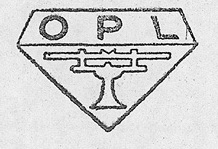 OPL, or Optique & Précision de Levallois was at one time one of the world’s oldest optics companies, predating many more well established German and Japanese companies.
OPL, or Optique & Précision de Levallois was at one time one of the world’s oldest optics companies, predating many more well established German and Japanese companies.
OPL was founded in 1919 by Armand de Gramont the Duke of Guiche, then 12th Duke of Gramont. Armand de Gramont was a French industrialist and scientist, born on September 29, 1879 who in his earlier years was fond of painting. In 1904, Gramont showed off his talents and had an art exhibition at the Salon des Artistes Français. Despite his talents, Gramont’s family pushed him towards a more serious career in the sciences.
Around 1910, Gramont established the Institute of Theoretical and Applied Optics and the Superior School of Optics, two organizations he would remain connected to for the rest of his life.
During the first world war, Gramont observed that the French military was lacking in both precision optics equipment and engineers to develop anything new, so in 1916, he and the Institute of Theoretical and Applied Optics established principles that were taught for the creation of military optical equipment. At this time, Gramont’s contributions were only of the educational kind, and he was not involved in the design or creation of any new equipment, only how to do it.
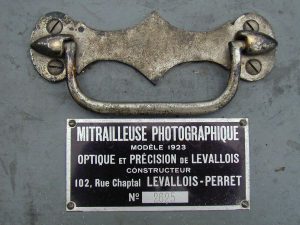
In 1919, Gramont would form a dedicated company called Optique & Précision de Levallois for the purpose of creating optical devices such as rangefinders, scopes, and other optical devices exclusively for the French military. This would remain how things were until 1938, at which time, Gramont wanted to expand to civilian production and start selling cameras and other devices to customers other than the French military.
To accommodate new product lines, a new factory was built in Châteaudun exclusively for civilian consumption. Although several sources online suggest this new factory was created in 1938, I could not find any evidence of cameras or other consumer products until after the war. It is plausible that just as the factory was about to get started, it shifted over to war production, much like optics factories all over the world did.

An early prototype, thought to have been built in either 1942 or 1943 appeared in the March 1954 issue of FOCAgraphie Magazine featured a body that closely resembled the Foca PF1 from a couple years later, with a screw lens mount, and a limited selection of shutter speeds. Strangely, within the film compartment was a mask that would have produced tiny exposures, possibly around 12mm x 18mm, suggesting, this might have been a special purpose camera, not for general photography.
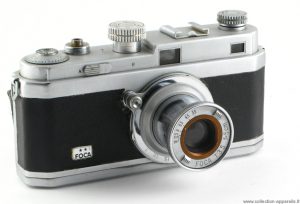
Beyond this one prototype, little is known what OPL worked one between 1938 and 1945 when the rangefinder equipped Foca PF2 was released. A year after its release, the non-rangefinder equipped PF1 went on sale, with both cameras closely resembling the 1942 prototype.
All Foca cameras of this era used a proprietary Foca screw mount which had a diameter of about 36mm. Screw mount Focas had a body mounted focus helix which only worked for 50mm lenses. You could still use lenses of different focal lengths, but they would no longer be coupled to the rangefinder. These cameras can easily be distinguished by a rounded depth of field chart near the bottom right corner of the lens mount. Lenses made for screw mount Focas were incompatible with any other system and because the mount was smaller than the 39mm wide lens mount used by the German Leica cameras, it meant those lenses were incompatible with what some people called the “French Leica.
Between the years of 1947 and 1957, a huge number of different Foca models were made in what is generally called the PF2 and PF3 series. Minor variations are found in both models depending on the years the cameras were made. This French language site does a pretty good job of explaining the differences. I won’t duplicate that info here, but if you’re interested, check it out.
Although screw mount Foca cameras were produced for quite a while, in April 1949, a new type of camera with a unique bayonet lens mount was shown at the Salon de la Photographie. In addition to bayonet lenses being easier and faster to mount, each of these lenses would have their own focus helix built into the lens, which means that swapping lenses of different focal lengths would still work with the camera’s rangefinder improving compatibility with a larger number of lenses.
The new Foca, called the Universel (not Universal) made its debut in 1950 with a new 3-claw bayonet and a series of six lenses ranging from 28mm to 135mm. The camera was built on the same body as the Foca PF3 and outwardly looks very similar. In fact, at a quick glance, the only obvious difference between a Universel and the original PF3 is the lack of the curved depth of field scale sticking out of the side of the original screw mount.
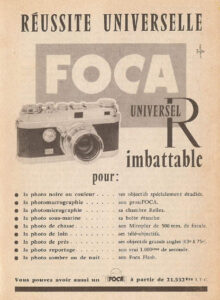
The Foca Universel would be updated in 1955 with a new model simply called the Foca Universel R, which added a film advance lever to the top plate of the camera. The use of the wind lever replaced the need to rotate the shutter speed dial to advance the film and cock the shutter. You can still do it on the “R”, but the lever is much more convenient. Other changes to the Universel R were the addition of a self-timer, the relocation of the A/R film transport switch from the front to the rear of the camera, relocating the shutter release button from the rear edge of the top plate to the front edge, and a larger diameter rewind knob which was easier to turn. Each of these changes, while minor by themselves, resulted in the Universel R being a much more capable and modern camera.
In May 1962, a third Foca Universel model, called the RC was announced which dramatically increased the size of the viewfinder and rangefinder windows, also requiring an entirely new top plate. The only other change to the camera was that many of the camera’s dials were painted with black enamel.
The Foca Universel series would be produced until 1964 with a total production of less than 40,000 units. The Universel RC was the least common with just over 2000 made.
In my research for this article, I found no evidence that Foca rangefinders were sold outside of France. These cameras were primarily made for the French market as postwar tariffs resulted in German goods being extremely expensive and difficult to obtain.
The only reference to the price of a Foca Universel comes from a 1957 ad in which the Foca Universel R with Oplarex f/1.9 lens cost 98,800 franc, and a Leica IIIf with 50mm f/2 lens cost 117,000 franc.
Although this article is about a Foca interchangeable lens rangefinder, the company made other cameras too. In 1955, a new line up of simpler and less expensive Focasport cameras was created. The first model, simply called the Focasport, was a simple scale focus camera with an Atos leaf shutter with a top speed of 1/300. It came with a Foca Neoplar 4.5cm f/3.5 triplet with front focusing. The Focasport line would continue well into the 1960s with models like the Focasport II C in 1963.
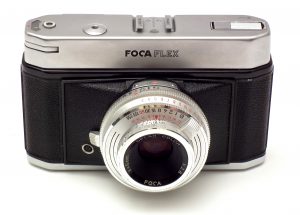
In 1960, OPL even produced a leaf shutter Foca SLR called the Focaflex which had a uniquely designed flat top hiding a series of mirrors that took the place of a pentaprism normally found in an SLR. Sylvain Halgand has a list of most Foca branded names on his website which shows how complex the company’s offerings were.
According to Gérard Langlois’s Foca camera website, the last model, a plastic Instamatic camera called the Foca Marly was made in 1967, but I don’t see anything after that. Shortly before the last models were produced, in 1964, Optique & Précision de Levallois merged with Société d’Optique et de Mécanique de Haute Précision, makers of SOM-Berthiot lenses. It seems that as camera production wound down, the combined company focused its efforts elsewhere, ending the era of the Foca camera.
Today, the interchagneable lens Foca cameras are desirable especially in countries like the United States in which they were not originally exported to. These cameras, even the most basic models are curiosities to American collectors and models that don’t show up often. When one of the more capable models like the Universel R do show up, especially with some of the other lenses or accessories, they can fetch quite a high price. Many collectors today unfairly categorize them as Leica copies, a label which I do not agree with. Other than having interchangeable lenses, a rangefinder, and being a camera, there is little that is similar between the two. Instead, these Foca cameras should be labeled what they are, quality made French cameras.
My Thoughts
I try not to have too many “rules” for this site, mainly because I am the only one who works here and I pretty much can do whatever I want with it, but in the interest in having the most diverse reviews as possible, I try not to review cameras that are too similar to one I already reviewed. This explains why I would review the Nikkormat FT3, but not the FTn, or the Leica IIIg but not the IIIf or similar.
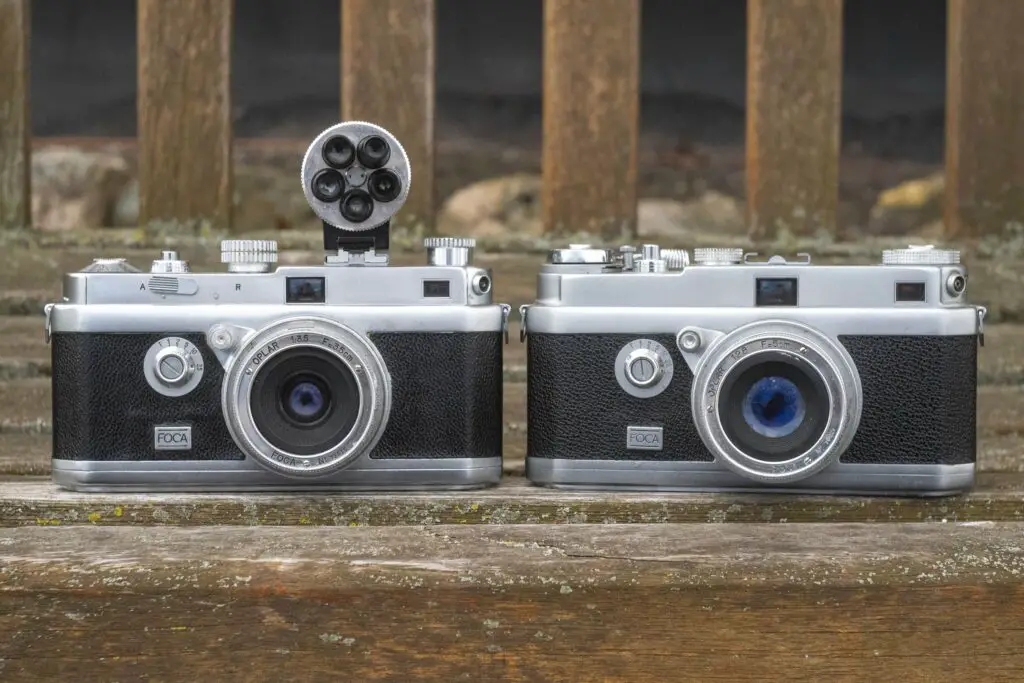
In the case of the Foca Universal R, I previously reviewed the very similar Foca PF3 back in 2020, but that camera had a bad shutter and I was never able to shoot it. In addition to wishing I had another chance to shoot an interchangeable lens Foca rangefinder, many readers of my site had lamented the fact that the review was incomplete and encouraged me to try again. When I came across this Foca Universel R with the bayonet mount, lever advance, self-timer, and most importantly, working shutter, I knew I needed to give it a go.
Like that original PF3 I had a couple years ago, this Universel R was in very nice cosmetic condition. Build quality was up there with German rangefinders as the camera felt solidly built with tight tolerances and each of the camera’s moving parts were neither too stiff, nor too loose. Like any high quality camera, with regular service, I believe these Focas would be up to the task of a lifetime of use as good as any German camera. With the 5cm f/2.8 Foca Oplar lens mounted, the camera had good balance and had the right amount of heft to feel substantial, without being a bother while carrying it around all day. With the lens collapsed, it could easily slide into a medium coat pocket or small handbag.T
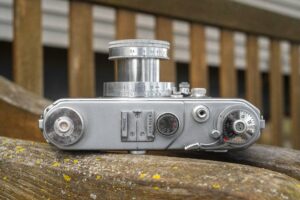
The top plate starts with a large diameter rewind knob which also has a film type reminder dial on it. The large knob is flatter than most but can be lifted into a raised position for easy rewinding and the larger diameter means that less turns are required to get through an entire roll. In the middle is an accessory shoe with the camera’s engraved serial number and a reminder that the camera comes from France.
Next is the shutter speed selector, which on the PF3 also doubles as the film advance knob. Using the shutter speed dial as the film advance seems like a strange design choice and while the Universel R adds a proper film advance lever, this knob can still be used to advance the film and cock the shutter, although it is very awkward to do. My recommendation is to not do this, and just use it to change speeds which requires you to lift up on the outer edge and rotate it until a dot lines up with one of the speeds 1/40 to 1/1000 plus Bulb. The Foca does have slow speeds, but they are controlled by a separate dial on the front of the camera.
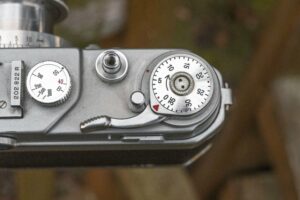
On the right side of the camera is the cable threaded shutter release which is relocated into a more ergonomically comfortable location near the front edge of the top plate compared to the PF3 which was located near the back, the combined film advance lever and exposure counter, and to the left of the advance lever the self-timer. The exposure counter is subtractive, showing the number of exposures remaining on a roll and must be manually reset after loading in a new roll of film. The self-timer, which it took me quite a while to figure out what this was, works by pushing it forward towards the shutter release until it lines up with small red dot next the upper left corner of the exposure counter. With the self-timer lined up with the red dot, it will lock into position. You can set the self-timer with or without the shutter being cocked, but you have to wind the lever in order to activate it, which is done by pressing down on the self timer lever itself. With the self-timer set, pressing the regular shutter release will not activate it.
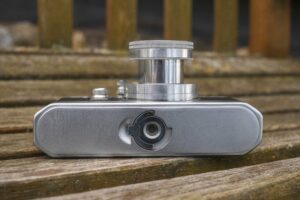
The bottom of the camera has a 3/8″ tripod socket which was a commonly used size for European tripods in the first half of the 20th century. In order to mount this camera to a modern tripod with a 1/4″ screw, you’ll need an adapter. Around the tripod socket is the film door release, which works by folding up and then giving it a quarter counterclockwise turn. With the lock released, the entire back and bottom come off as one piece.
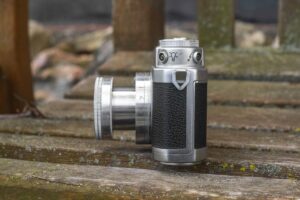
The sides are mostly symmetrical with hinged strap lugs on both side allowing for each attachment of your strap of choice. On the left side, above the strap lug are two PC flash sync ports, one for flashbulbs and the other for electronic flashes. The X-sync on the Universel R is 1/40 seconds, which is improved from earlier models which were 1/25.
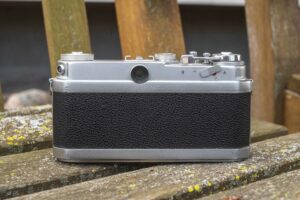
The back is mostly uneventful other than the round eyepiece for the viewfinder and to its right a film transport switch. The location of this switch is relocated from the front of the camera like on previous Foca rangefinders, but works the same way. When turned to “A”, the film transports normally, and when turned to “R” the transport is deactivated so that you may rewind the film. Aside from that, the door has a large swath of body covering, which on this example was in very good condition, showing no signs of peeling or cracking.
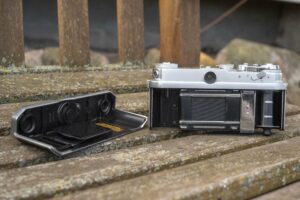
With the back removed from the camera, you have easy access to the film compartment which at first glance looks pretty ordinary, but has some differences compared to other 35mm cameras. The film transports from left to right onto a removable metal take up spool. The take up spool on the Foca is unique to Foca cameras and incompatible with any other I’ve seen. This causes an obvious problem where if you were to lose this spool, you cannot use the camera without locating another. Assuming you have the spool though, it works like most other with a single metal clip that you slide the film leader under.
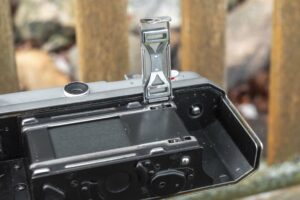
Another difference is that the Foca has a hinged chrome piece of metal that covers the sprocket shaft. You must lift up on this piece before threading film as it must pass beneath it. Inside the film door is a black painted metal pressure covered in divots which help reduce friction as film passes over it. Next to the pressure plate is a notice printed in yellow which warns you to leave the shutter uncocked when not using the camera.

Looking down upon the 5cm f/2.8 Foca Oplar lens, the most important thing to remember is that the lens is collapsible, so you must extend and lock it into position before firing the shutter as that will result in grossly out of focus images. The camera has no mechanism to prevent you from firing the shutter while the lens is collapsed. Focusing the lens is done by using a lever to the side of the lens which locks at infinity. To unlock the lens from infinity, press inward on the button on the end of the handle while turning the focus arm counterclockwise.
An oddity of the 5cm f/2.8 Oplar lens is that the lens barrel can be rotated a full 360 degrees before extending it, and after extending it, can be locked into multiple positions whcih causes the aperture scale to point in a variety of directions, including down. If after extending the lens, you find that the aperture scale is pointing down or to the wrong side of the camera, partially collapse it, then rotate the lens until you can see the scale and then re-extend and lock it into position. I am uncertain if this is normal as the only other bayonet Foca lens I have is the 3.5cm which is not collapsible and doesn’t have this problem. Other than this oddity, the aperture ring works as you’d expect, although I found it to be extremely thin. making it difficult to locate with the camera to your eye.
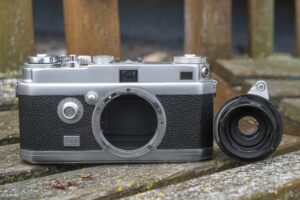
The Foca Universel R uses a bayonet lens mount which is different from the Foca PF3 which used a screw mount. The bayonet mount on this camera has a release button which is normally hidden under the lens focus arm at the infinity position. In order to dismount the lens, you must turn the focus arm away from infinity and then press and hold the button underneath it while rotating the entire lens counterclockwise. I did not love the location of the release button, but I guess it works well enough.
Reinstalling the lens requires lining up two red dots, one each on the lens and the other painted over a screw at the 12 o’clock position of the lens mount. To the left of the lens mount is the slow speed dial which requires the top shutter speed dial to be at the 1/40 speed. Speeds from 1 second to 1/40 plus T can be set using this dial. As with most mechanical cameras, it is advised that you do not use the slow speeds unless you are certain the shutter is in good working order, or has recently had a CLA.
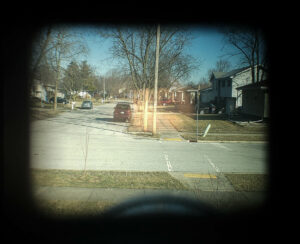
In the years since the Foca PF3 and Universel R were made, quite a few things were improved, but unfortunately, the viewfinder is not one of them. The Foca uses a combined incident combined image rangefinder where the main viewfinder has a bluish tint and the rangefinder patch is clear, however the entire thing is very tiny. While wearing prescription glasses, you don’t come anywhere close to seeing the edges of the image. Even when I remove my glasses, I have to press my face uncomfortably close to the camera to see the edges of the visible image, and I suspect people who don’t wear glasses, would likely take offense to such a tiny and tight viewfinder, especially for a camera made in 1955. As a prescription glasses wearer, I am somewhat used to using cameras in which I am unable to see all four edges of the image. My process is just to focus using the rangefinder, make sure that the center of what I am photographing is visible, and not try to make too many tight compositions so that I have a little bit of wiggle room on the edges. If it becomes a big issue, I can attach an auxiliary 50mm viewfinder to the shoe.
One final oddity to the Foca’s design is that the rangefinder window is on the opposite site of the camera than most rangefinder cameras. Functionally, this doesn’t make a difference as the rangefinder works fine, but depending on how you grip the camera, you need to take care not to block the rangefinder window with your left hand while shooting.
For French photographers or those in countries where importing cameras from Germany was too expensive or prohibited altogether, the Foca was a really nice alternative to the Leica. The build quality is very good, the lenses are good, and feature for feature, the Foca Universel R compares favorably on all things except the viewfinder and a somewhat quirky film compartment. Overall, I’d say this is a pretty capable camera that should be pleasant to use and make fine images. But does it?
My Results
The day that came to shoot the Foca Universel R, I didn’t want to take any chances, so I went with some fresh Fuji 400 that I had recently purchased. My first attempt to shoot a Foca didn’t work out so I wanted to be sure that if I only got one shot at a working model, at least the film wouldn’t be the problem. As it would turn out, the camera ended up working great, so I probably could have shot anything I had, but still, the Fuji 400 was a good choice.
One of the greatest compliments I can pay the Foca Universel R is that while shooting the camera, I forgot that I was shooting a French camera largely unknown to westerners. The Foca certainly had its fans in France and other European countries, but this is a camera which had not developed a fervent following like so many other German or Japanese cameras and I can’t understand why.
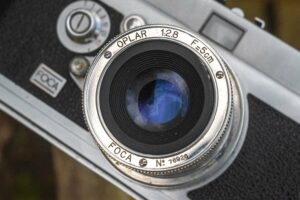
The images made by the Oplar 5cm f/2.8 were quite good. I wish I had the faster f/1.9 Oplarex in bayonet mount but I doubt that even if I had, if the images would have looked any different. For what I believe to be a 4-element Tessar style lens, the “lesser” Oplar lens did as good of a job as countless other similar lenses. Images were very sharp in the center with only a subtle softness near the edges. I saw a tiny amount of vignetting near the corners in images where the sky was visible, but nothing that would make me question its quality.
I did not shoot any black and white film through the camera, but I suspect that my opinion of the lens as a quality midrange lens would not change. By the time these lenses were made, it didn’t matter whether it was made in Germany or France, the images will look nice on all film stocks.
Using the camera was a pleasant experience. While the first Foca PF3 I had didn’t work correctly, I still have that camera and find that advancing the film via the shutter speed dial is a bit weird. The Universel R with the rapid wind lever is much more natural feeling and allows you to ready your next shot much faster than with the dial.
Another pretty significant improvement which is something I’ve discussed in my reviews of Nikon rangefinders is that the older Focas have the shutter release nearer the back edge of the top plate, which is just far enough back to contort my right index finger in a way that’s less than perfect. With the Universel R, the shutter release is in a much more comfortable location nearer the front edge of the camera. For someone who questions how much of a difference such a small change makes, I ask you to reserve judgement on me until you’ve handled both cameras. I’d be willing to bet, more times than not, people would prefer the front location of the shutter release over a rear one. At the very worst, maybe some won’t notice, but I did.
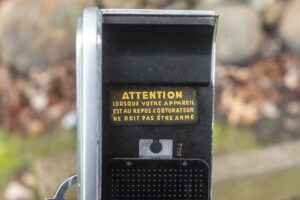
As for the other changes like the relocated A/R switch, self-timer, and larger rewind knob don’t make significant differences, but just refine an already good design and make it just a bit better.
The viewfinder is isn’t large, but is acceptable for a mid 1950s rangefinder. Wearing prescription glasses, I was unable to see all four edges of the viewfinder, but I was able to overcome that by not framing my images too tightly. On the plus side, this example was clean and accurate with good contrast, so I had no issues using it other than not being able to see the edges.
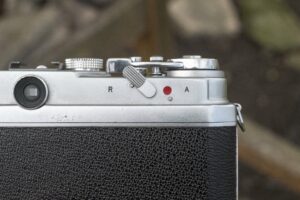
One ergonomic challenge I experienced which happens on all Foca rangefinders, is that the arrangement of the viewfinder and rangefinder windows is opposite of most rangefinders. When holding the camera to your eye, the rangefinder window is nearer your left hand instead of your right. People like myself who have shot a large number of rangefinders, are familiar with cameras like the Zeiss-Ikon Contax II and III in which the rangefinder window is near the extreme right edge of the camera. This causes the rangefinder to be easily blocked by your right hand. To circumvent this, a so called “Contax grip” is required to as not to block the window. The Foca is similar, except you need to do it with your left hand. In use, this wasn’t a dealbreaker, rather it was a mild annoyance that I had to keep reminding myself to change how I handled the camera.
The general build quality and usage of the camera was pretty good. Maybe not to the best Leica standard, but certainly on par with most Japanese interchangeable lens rangefinder cameras. I now have three Focas (plus a Focasport) in my collection and this is the best of the bunch. The history of the French camera industry suggests that getting cameras imported was expensive, so companies like OPL had to step up their game and release a range of quality cameras, and I’d say that they largely succeeded. The Foca Universel R may not be the best camera ever made, but it is fun to use, makes good images, and had no deal breakers. I’d call that a win!
Related Posts You Might Enjoy
External Links
http://camera-wiki.org/wiki/Foca_Universel
https://mfbernard79.wordpress.com/appareils-photographiques-legendaires/foca-luniversel/
http://www.lumieresenboite.com/collection2.php?l=2&c=Foca_Universel_R
https://rangefinderforum.com/threads/the-exotic-foca-from-france-not-your-dads-leica-copy.177622/

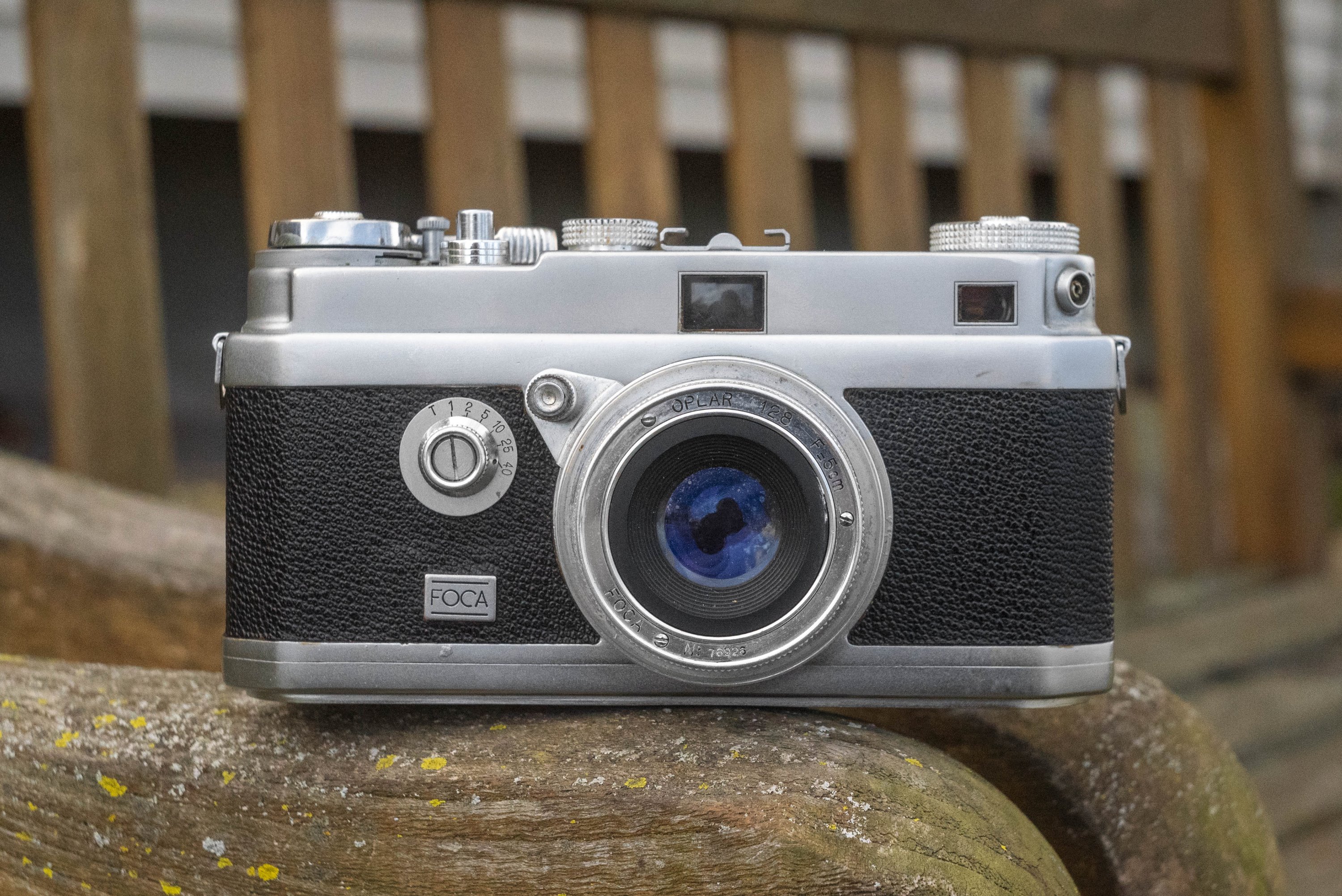
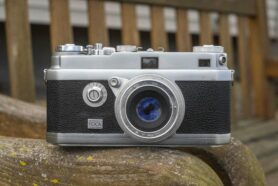
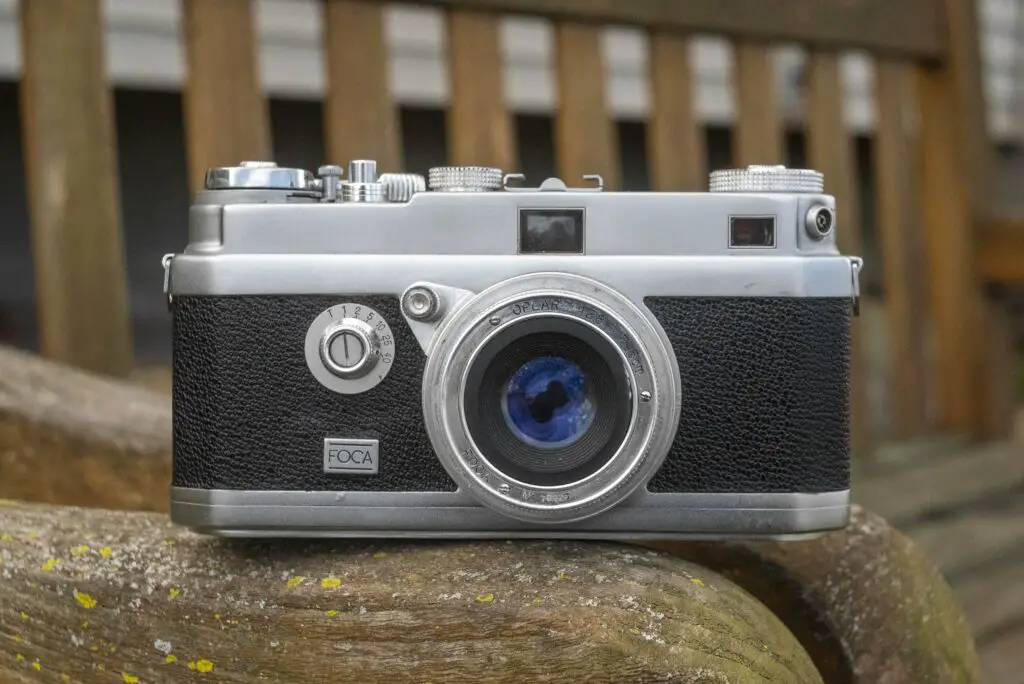
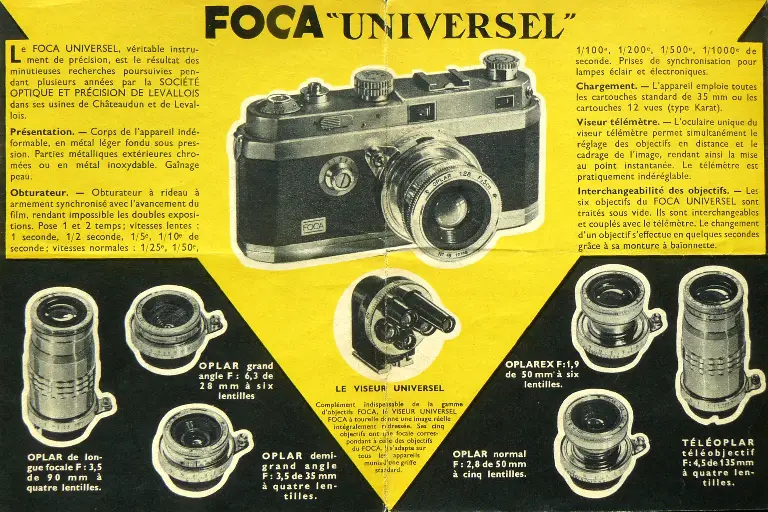


















Hi Mike. I have to say I have been waiting for this post to be published.
I have a PF3L (with the lever wind) which dates from 1960/61 and is a near cousin of the Universel.
Although this was bought from a well-known photographic chain here on the UK, it’s being serviced as I bought it at a bargain price as the screw-mount Oplar 5cm/f2.8 lens had been jammed by a previous owner. That and the fact that the shutters are notoriously fragile – particularly the low speeds made a CLA a must.
I also have a very battered PF2 that needs new curtains – but (lacking the slow speeds) fires nicely all day long. I bought this as a donor camera as the PF3L arrived minus its take-up spool – (typically French) unique design that is very difficult to find and (seeming impossible to substitute).
I visit France often and (unsurprisingly) Foca cameras of all types are fairly common. The difficulty is finding a working example as many repairers will not touch them, partly as they needed specialist tools.
Be prepared for expensive bills!
Unlike the Universel the finish on these cameras is often poor with the chrome bolstering and flaking away.
I did however see a PF2 with a collapsible OPL 5cm/3.5 in a secondhand camera shop in Paris for 149€ (January 2024). An Argus C Forty-Four the same shelf was 99€ and a nearby Canonet was 129€.
Given all the above I love my Focas – but I also have three different FSU rangefinders too!
Universels are rarer and I see them mostly online from either specialist camera retailers in France (french-camera.com) or the usual internet auction site.
Universels were used by the French armed forces and specialist examples exist such as those used by the French Navy’s submarine service for capturing images through periscopes.
And finally, I agree that Leica comparisons are wrong.
If pushed I’d say that they were more like Contax cameras, with the body-mounted focusing helicoid – and the fact that like Contax, Foca is no more.
In its passing we have lost an innovative company (see Focaflex) that was just a step or two behind the leaders.
I’m curious to know who you’re having service your PF3. I’ve got a PF2 (bought in Paris) that is basically in good shape, but could use a good CLA.
Please let us know who that repair person is, I have an Universel R that needs a shutter repair and as you mention, many of the tools are unique to FOCAs.
Hi Andrew,
I’m new to all this including repairs and so forgive me if I come across as over cautious, but I’d like to make the following clear so you and Andreas (and perhaps others) can know the background before making your decision.
I’ve only used a camera repair place once before and that was for sensor replacement.
The place I used was good but (to my mind) very expensive – perhaps because it is based in a ‘creative-heavy’ part of London.
They do also do analogue and I approached them about a CLA to a Zorki 4. They quoted me twice the cost of a body they had refurbed and had for sale on their website.
I decided to look elsewhere.
I approached the guy I eventually sent my Focas too and sounded him out about the Zorki CLA. His cost was more reasonable.
I didn’t have the Zorki CLA’d as the Focas took priority.
When I enquired about him working on them, he said he’d have a look. He didn’t provide any assurance that he could CLA/fix them.
He has a long lead time: he accepted them six weeks ago and will assess them in and hopefully start work on them on May as he operates on a three-month lead time.
When you first send the items in you pay an initial inspection fee up front.
Although I haven’t used him, I did buy a lens refurbished by him off his website. It was a fair price and works well.
His name is Pierro Pozella and is on his mid- twenties.
He is becoming known here in the UK as he now is the camera repair specialist on the BBC programme ‘The Repair Shop’ and has been featured elsewhere (see the ‘About’ section on his website.
Website details: https://pppcameras.co.uk
If you can wait until Pierro has given me an indication of whether he can do the necessary I can update you and Andreas.
Apologies for the long-winded reply but as I say I haven’t had anything repaired by him and so can’t recommend him from experience having dealt with him previously – but I have high hopes.
Hi Andreas,
Firstly, could I refer you to my reply to Andrew above?
Secondly, I’m also aware that Foca PF/Universel series cameras have their own special tools – that’s another reason why I’m being cautious about the chap I’ve sent my cameras to!
But as I have said in reply to Andrew, I have high hopes!
Kind regards to you and Andrew.
Apologies Andrew,
I got distracted part-way through and it seems as if my reply to you has come up under a reply to Andreas – although the info is relevant to both of you.
I realise that the info isn’t as concise as I would like but with competent repair techs getting scarcer and scarcer, I don’t want to be in the position of getting other people’s hopes up (and their wallets lightened) if things don’t work out as hoped for.
As they say the proof of the pudding is in the eating!
In France, Formosaflash and Thomas Weiss (@bobinette_photo on Instagram) both have the necessary tools and know-how to repair some (if not all) Foca rangefinder cameras.